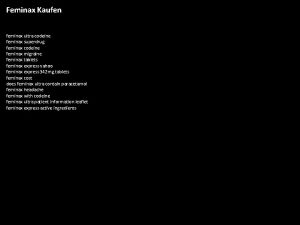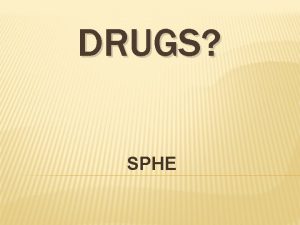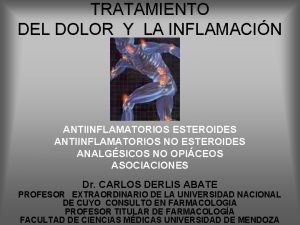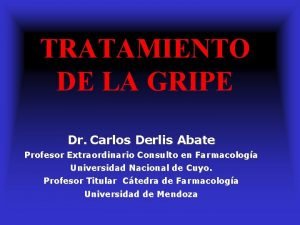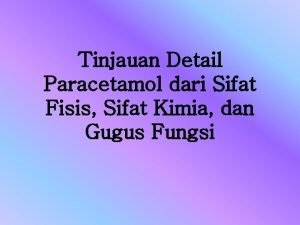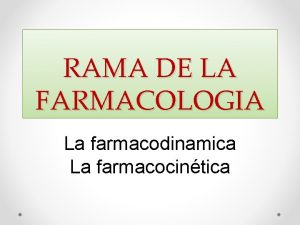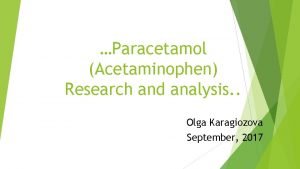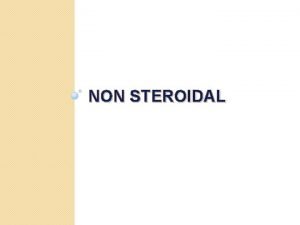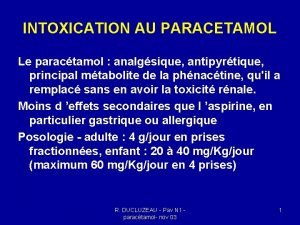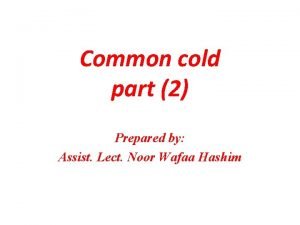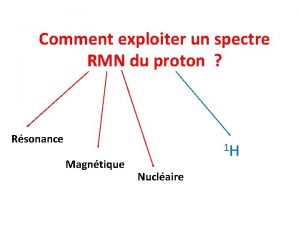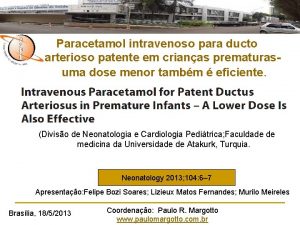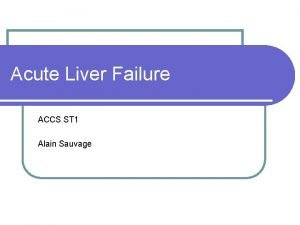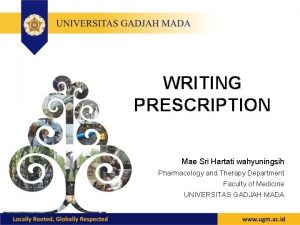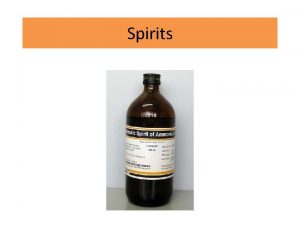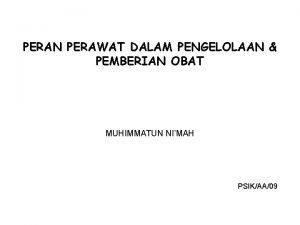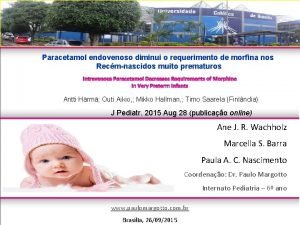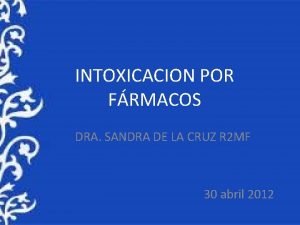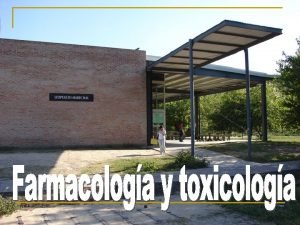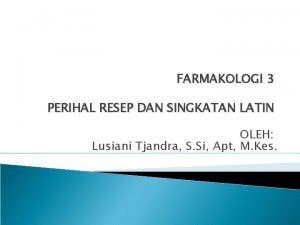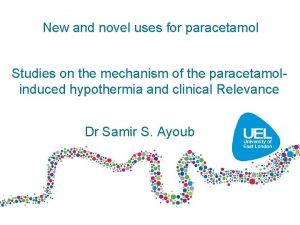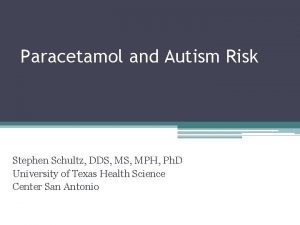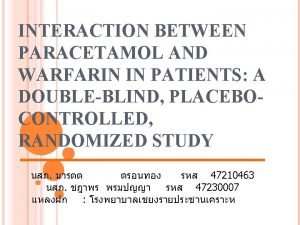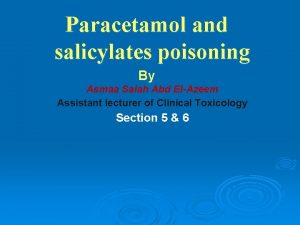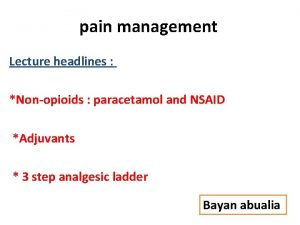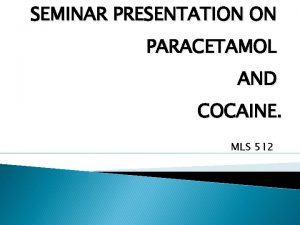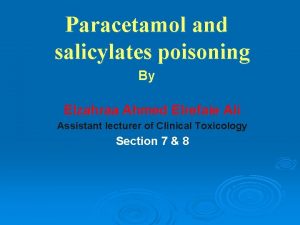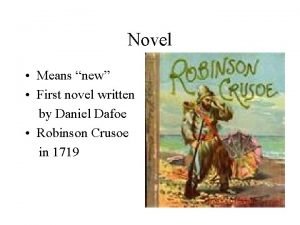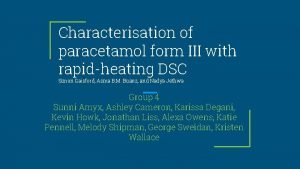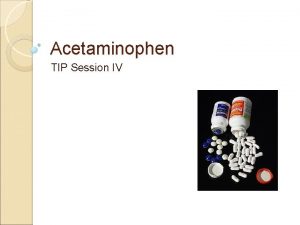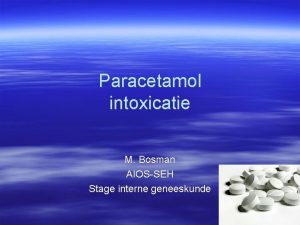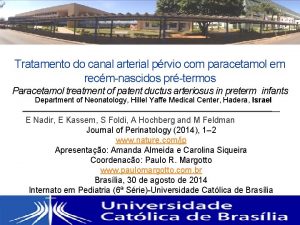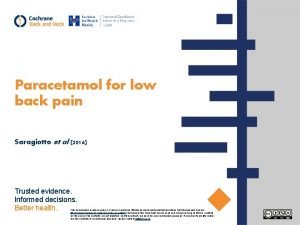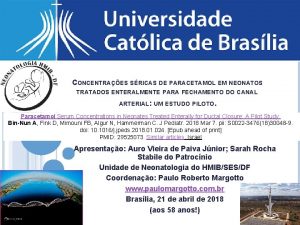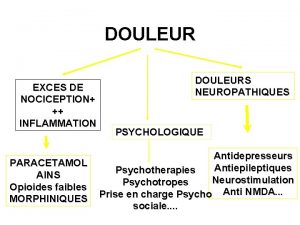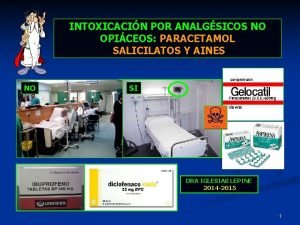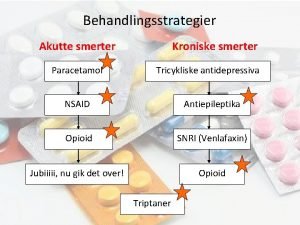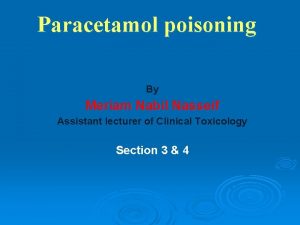New and novel uses for paracetamol Studies on




































- Slides: 36

New and novel uses for paracetamol Studies on the mechanism of the paracetamolinduced hypothermia and clinical Relevance Dr Samir S. Ayoub

Paracetamol • Analgesic and anti-fever drug with weak antiinflammatory effects • Used clinically for over a century • Mechanism of pharmacological action still not fully established • Cyclooxygenase (COX) enzymes are involved in production of prostaglandins, which mediate inflammation, pain and fever • Suggested to work by inhibition of COX enzymes activity in the central nervous system (CNS)

Mode of action of NSAIDs work by inhibition of prostaglandin biosynthesis by inhibition of COX activity Inhibition 100 (%) 80 Indomethacin Aspirin 60 Salicylic acid 40 20 0 0. 1 1. 0 10 Log concentration (µg/ml) Sir John Vane, Nobel laureate 1981 1000 (Vane, Nature 1971)

Inhibition of COX activity by paracetamol is tissue selective - in vitro assay ID 50 µgml-1 Synthetase from: Indomethacin Sodium aspirin 4 - Acetamidophenol Dog spleen 0. 06 6. 6 100. 0 Rabbit brain Dog brain 1. 3 11. 0 14. 0 12. 5 (Flower and Vane, Nature 1972) Professor Roderick J Flower, FRS

Prostaglandins synthesis

Prostaglandins and NSAIDs Prostaglandins Pain Fever Inflammation GI protection NSAIDs Analgesic Antipyretic Anti-inflammatory GI damage

Hypothesis Paracetamol acts by inhibition of COX activity in central tissues

Paracetamol is centrally acting • The antipyretic effect of paracetamol was accompanied by potent reduction in PGE 2 levels in the cerebrospinal fluid (Feldberg et al 1972) • Reduced spinal cord released of PGE 2 in response to capsaicin (Malmberg & Yaksh, 1994) • Reduced spinal cord released of PGE 2 in the formalin test, but not the urinary excretion of PGE 2, PGF 2 & 6 -keto-PGF 1 (Muth Selbach et al 1999) • Reduced the pain threshold in the flexion reflex to transcutaneous electrical stimulation in man, which is a model of central nociception (Piletta, et al, 1991)

IC 50 values (µg/ml) of NSAIDs on COX-2 or COX-1 activity in intact cells Ratio COX-2 COX-1 NSAID COX-2 COX-1 Tolmetin 7 0. 04 175 Aspirin 50 0. 3 166 Ibuprofen 15 1 15 Paracetamol (IC 30) 20 2. 7 7. 4 Diclofenac 0. 35 0. 7 Naproxen 1. 3 2. 2 0. 6 Celecoxib 0. 34 1. 2 0. 3 Rofecoxib 0. 84 63 0. 013 Mitchell J et al. (1993) 90(24): 11693 -7

The Discovery of Cyclooxygenase-3 COX-3, a cyclooxygenase-1 variant inhibited by acetaminophen and other analgesic/antipyretic drugs: Cloning, structure, and expression N. V. Chandrasekharan, Hu Dai, K. Lamar Turepu Roos, Nathan K. Evanson, Joshua Tomsik, Terry S. Elton, and Daniel L. Simmons* Department of Chemistry and Biochemistry, E 280 Benson Science Building, Bringham Young University, Provo, UT 84602 Communicated by John Vane, William Harvey Foundation, London, United Kingdom, August 5, 2002 (received for review April 17, 2002) § Splice variant of COX-1 § Most abundantly expressed in cerebral cortex § Selectively inhibited by paracetamol Professor Daniel Simmons, Brigham Young University, . Utah, USA

IC 50, (m. M) Drug Paracetamol Aminopyrine* Antipyrine Dipyrone Phenacetin Aspirin Diclofenac Ibuprofen Indomethacin Caffeine Thalidomide COX-1 >1000 350 >1000 10 0. 035 2. 4 0. 010 >1000 COX-2 >1000 >1000 0. 041 5. 7 0. 66 >1000 COX-3 460 688 863 52 102 3. 1 0. 008 0. 24 0. 016 >1000 All assays were carried out in the presence of 30 m. M arachidonic acid. *4 -dimethylaminoantipyrine. Chandrasekharan et al, 2002

Is thermoregulatory function of paracetamol mediated through inhibition of COX-3?

The reduction of basal body temperature with 300 mg/kg paracetamol correlates with reduction of brain PGE 2 levels 39. 0 200 o 38. 0 37. 5 37. 0 100 36. 5 36. 0 35. 5 0 0 1 2 3 4 5 Time (h) Paracetamol hypothermia is related brain PGE 2 levels PGE 2 (pg/well) Body Temp ( C) 38. 5

COX-3 is constitutively expressed in brain tissues of mice Cerebral cortex Mid brain Brain stem Cerebellum COX-1 (72 KDa) COX-2 (72 KDa) COX-3 (65 KDa)

Time-profile to the effect of 300 mg/kg paracetamol on the basal body temperature in COX-1 & COX-2 genes knock-out mice COX-1 gene knockout mice COX-2 gene knockout mice Paracetamol hypothermia is reduced in COX-1 knockout mice and is retained in COX-2 knockout mice

The effect of 300 mg/kg paracetamol on brain PGE 2 levels after 1 hr COX-1 gene knockout mice COX-2 gene knockout mice Reduction in the hypothermic effect of paracetamol in COX 1 -/- mice is linked to loss of the effect of paracetamol on brain PGE

The effect of SC 560 & Celecoxib alone and in combination with paracetamol on the basal body temperature of mice Inhibition of COX-1 and COX-2 does not cause hypothermia

1. Conclusions Reduction of basal body temperature by paracetamol confirms similar findings in humans (Dippel et al, 2003; Tittelboom et al, 1988; Denes et al, 2002) The dose-dependency & time-profile of the reduction of temperature confirms that the effect is related to paracetamol. Correlation of reduction of body temperature and brain PGE 2 confirms that paracetamol targets a central COX enzyme. The reduction in paracetamol-induced hypothermia and brain PGE 2 in COX-1 knockout mice confirms that the likely target for paracetamol is a COX-1 variant protein and not COX-1 as the COX-1 selective inhibitor, SC 560, had no effect on temperature.


Paracetamol is converted to N-arachidonylamine phenolamine (AM 404) in the brain by the action of fatty acid amide hydrolase (FAAH) Högestätt et al, 2005

The tissues involved in the conversion of paracetamol to AM 404 Fatty acid amido hydrolase enzyme (FAAH) CB 1 receptor TRPV 1 channel Mallet et al, 2008

AM 404 has analgesic (La Rana et al. , 2008 & 2006; Mitchell et al. , 2007; Costa et al. , 2006) and hypothermic actions(Rawl el. , 2006) AM 404 activates the CB 1 receptor-mediated endocannabinoid and TRPV 1 channel systems (Guiffrida et al. , 2001; De Petrocellis et al. , 2000)

Activation of the brain endocannabionid system results in hypothermia Activation of the transient receptor potential vanilloid -1 (TRPV 1) in the brain, also results in hypothermia AM 404 is able to activate both the endocannabinoid and TRPV 1 systems Does AM 404 mediate the paracetamol-induced hypothermia through activation of the endocannabinoid and TRPV 1 systems? ?

Paracetamol-induced hypothermia and cannabinoids

Cannabinoid-induced hypothermia and COX

Paracetamol-induced hypothermia and TRPV 1

TRPV-1 -induced hypothermia and COX

AM 404 does not induce hypothermia

Inhibition of FAAH does not prevent the induction of hypothermia with paracetamol

Co-administration of paracetamol and CB 1 agonist produce additive hypothermia

Conclusions The paracetamol induced hypothermia is not dependent on the cannabinoid and TRPV 1 systems AM 404 does not mediate the paracetamol-induced hypothermia A COX-1 variant protein mediates the reduction of body temperature by paracetamol in normothermic and pyretic mice

Clinical relevance: therapeutic hypothermia Following a stroke, cardiac arrest or neurotrauma brain ischemia leads to significant neuronal cell death leading to long term disability or death. Induction of mild, sustained hypothermia is an established method for the acute management of such patients. Mechanism through which hypothermia protect the brain include, reduction in brain metabolic rate, blockade of excitotoxicity calcium antagonism, preservation of protein synthesis, a decrease in oedema formation, modulation of the inflammatory response and modulation of apoptotic cell death. Most of the damage occurs within the first hour “Golden hour”

Therapeutic hypothermia: the golden hour

Therapeutic hypothermia: Current methods used to induce therapeutic-hypothermia can not be used in the pre-hospital setting, large in size and expensive. * * *

Drug-induced hypothermia: fast onset of action Combinational hypothermia; paracetamol and cannabinoid agonist. Intravenous formulation Out-of-hospital use Induction of hypothermia within minutes “Inside-out” hypothermia Easily maintained hypothermia Cheap

The team Prof. Gavin Giovannoni (Consultant Neurologist, Royal London) Dr Rupert Pearse (Critical Care Consultant, Royal London) Prof. David Baker (Professor of Neuroimmunology, ICMS) Dr Samir Ayoub (Pharmacology lecturer, UEL)
 Feminax superdrug
Feminax superdrug Coffee with paracetamol
Coffee with paracetamol Paradigm shift from women studies to gender studies
Paradigm shift from women studies to gender studies Tafirol
Tafirol Mecanismo de accion del paracetamol
Mecanismo de accion del paracetamol Sifat fisikokimia paracetamol
Sifat fisikokimia paracetamol Uniporte simporte y antiporte
Uniporte simporte y antiporte Acetaminophen mechanism
Acetaminophen mechanism Paracetamol dose per kg
Paracetamol dose per kg Courbe de prescott
Courbe de prescott Paracetamol adverse effects
Paracetamol adverse effects Spectre rmn ethanol
Spectre rmn ethanol Paracetamol intravenoso patente
Paracetamol intravenoso patente Grupo funcional de las cetonas
Grupo funcional de las cetonas Hepatic encephalopathy stages
Hepatic encephalopathy stages Penulisan resep syrup
Penulisan resep syrup Hydroalcoholic solution of volatile substances
Hydroalcoholic solution of volatile substances 1 ml berapa gram
1 ml berapa gram Paracetamol endovenoso
Paracetamol endovenoso Via de administracion de la fenitoina
Via de administracion de la fenitoina Acido mefenámico
Acido mefenámico Singkatan uc dalam resep
Singkatan uc dalam resep Intoxicacion paracetamol
Intoxicacion paracetamol Fspos vägledning för kontinuitetshantering
Fspos vägledning för kontinuitetshantering Novell typiska drag
Novell typiska drag Nationell inriktning för artificiell intelligens
Nationell inriktning för artificiell intelligens Returpilarna
Returpilarna Shingelfrisyren
Shingelfrisyren En lathund för arbete med kontinuitetshantering
En lathund för arbete med kontinuitetshantering Kassaregister ideell förening
Kassaregister ideell förening Vilotidsbok
Vilotidsbok A gastrica
A gastrica Förklara densitet för barn
Förklara densitet för barn Datorkunskap för nybörjare
Datorkunskap för nybörjare Stig kerman
Stig kerman Mall för debattartikel
Mall för debattartikel För och nackdelar med firo
För och nackdelar med firo
